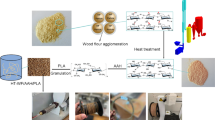Abstract
There has been growing interest in using poly (lactic acid) (PLA) fibres because of its natural-based origin and good biodegradability; however, its adoption within the textile industry has been limited to lower temperature wet and dry processing, because of its relatively lower glass transition temperature (T g) and melting point (T m). Here we report for the first time inkjet printing of heat-sensitive PLA fabrics using ambient temperature UV-curable inks as a way of overcoming the potential degradation at higher temperature. The UV cured inkjet printed PLA fabrics exhibited good performance characteristics such as acceptable colour fastness, relatively high colour strength, K/S, and comparable colour difference, ΔE, after washing to the thermally cured ink system, without affecting the physical and mechanical properties of the fabrics. In contrast thermally cured inkjet printed PLA fabrics exhibited significantly reduced bursting strength and stiffer handle attributed to the thermal degradation and lower fibre flexibility imparted at the higher temperature. Investigation of the radiation-cured printing approach indicates UV-curable inkjet printing may be considered as an alternative to conventional thermally cured pigment printing of heat-sensitive biodegradable PLA-based fabrics.














Similar content being viewed by others
References
Dawson T, Hawkyard C (2000) A new millennium of textile printing. Rev Prog Color Relat Top 30(1):7–20
Lin L, Bai X (2004) Ink-jet technology: status quo and future–relevance to surface coatings. Pigment Resin Technol 33(4):238–244
Zhang Y, Westland S, Cheung V, Burkinshaw SM, Blackburn RS (2009) A custom ink-jet printing system using a novel pretreatment method. Color Technol 125(6):357–365
Mochizuki M (2005) Properties and application of aliphatic polyester products, in biopolymers online. Wiley-VCH Verlag GmbH & Co KGaA, Weinheim
Mochizuki M, Hirami M (1995) Biodegradable fibers made from truly-biodegradable thermoplastics. In: Prasad P, Mark J, Fai T (eds) Polymers and other advanced materials. Springer, Berlin, pp 589–596
Gupta B, Revagade N, Hilborn J (2007) Poly (lactic acid) fiber: an overview. Prog Polym Sci 32(4):455–482
Mochizuki M (2010) Textie application. In: Auras RA et al (eds) Poly (lactic acid): synthesis, structures, properties, processing, and applications. Wiley, New Jersey
Avinc O, Khoddami A (2009) Overview of poly(lactic acid) (PLA) fibre. Fibre Chem 41(6):391–401
Reddy N, Nama D, Yang Y (2008) Polylactic acid/polypropylene polyblend fibers for better resistance to degradation. Polym Degrad Stab 93(1):233–241
Karim MN, Rigout M, Yeates SG, Carr C (2014) Surface chemical analysis of the effect of curing conditions on the properties of thermally-cured pigment printed poly (lactic acid) fabrics. Dyes Pigm 103:168–174
Edison SE (2010) Formulating UV curable inkjet inks. In: Magdassi S (ed) The chemistry of inkjet inks. World Scientific Publishing Company Pvt Ltd, Singapore, pp 161–176
Hancock A, Lin L (2004) Challenges of UV curable ink-jet printing inks-a formulators perspective. Pigm Resin Technol 33(5):280–286
Li S, Boyter H, Stewart N (2004) Ultraviolet (UV) curing for textile coloration. AATCC Rev 4(8):44–49
Loutz JM, Peeters S, Lindekens L (1993) Radiation-curable waterborne systems. J Coated Fabr 22:298
BSI, BS EN ISO 105-C06: 2010 textiles (2010) Tests for colour fastness. Colour fastness to domestic and commercial laundering. BSI, London
Fischer E, Sterzel HJ, Wegner G (1973) Investigation of the structure of solution grown crystals of lactide copolymers by means of chemical reactions. Kolloid-Zeitschrift und Zeitschrift für Polymere 251(11):980–990
Anderson K (2008) Curing inkjet printed pigments with ultraviolet light. In: TC2
Mikuž M, Turk SŠ, Tavčer PF (2010) Properties of ink-jet printed, ultraviolet cured pigment prints in comparison with screen printed, thermo cured pigment prints. Color Technol 126(5):249–255
Neral B, Šostar-Turk S, Vončina B (2006) Properties of UV-cured pigment prints on textile fabric. Dyes Pigm 68(2):143–150
Hutchinson I (2010) Raw materials for UV curable inks. In: Magdassi S (ed) The chemistry of inkjet inks. World Scientific Publishing Company Pvt Ltd, Singapore, pp 177–200
Xue C-H, Shi M-M, Chen H-Z, Wu G, Wang M (2006) Preparation and application of nanoscale microemulsion as binder for fabric inkjet printing. Colloids Surf A 287(1–3):147–152
Miles LWC (2010) Textile printing, 2nd edn. SDC, Bradford. ISBN 0901956333
Nishida H (2010) Thermal degradation. In: Auras RA et al (eds) poly (lactic acid): synthesis, structures, properties, processing, and applications. Wiley, New Jersey, pp 401–412
Yang QB, Sun YJ (2011) The mechanical property of PLA fibers under heat treatment. Adv Mater Res 321:184–187
Mondal S, Gupta B, Singh H (2003) Coating of polypropylene nonwovens with acrylic copolymers. J Ind Text 33(1):33–41
Acknowledgements
The authors kindly acknowledge the support of The University of Manchester Research Impact Scholarship for the PhD study of first author and also like to thank Dr Andy Hancock, Technical Director, Mexar Inkjet Solutions and Hybrid UK for the help with inkjet pigment printing and UV-curable inkjet printing, respectively.
Author information
Authors and Affiliations
Corresponding author
Rights and permissions
About this article
Cite this article
Karim, M.N., Afroj, S., Rigout, M. et al. Towards UV-curable inkjet printing of biodegradable poly (lactic acid) fabrics. J Mater Sci 50, 4576–4585 (2015). https://doi.org/10.1007/s10853-015-9006-0
Received:
Accepted:
Published:
Issue Date:
DOI: https://doi.org/10.1007/s10853-015-9006-0



